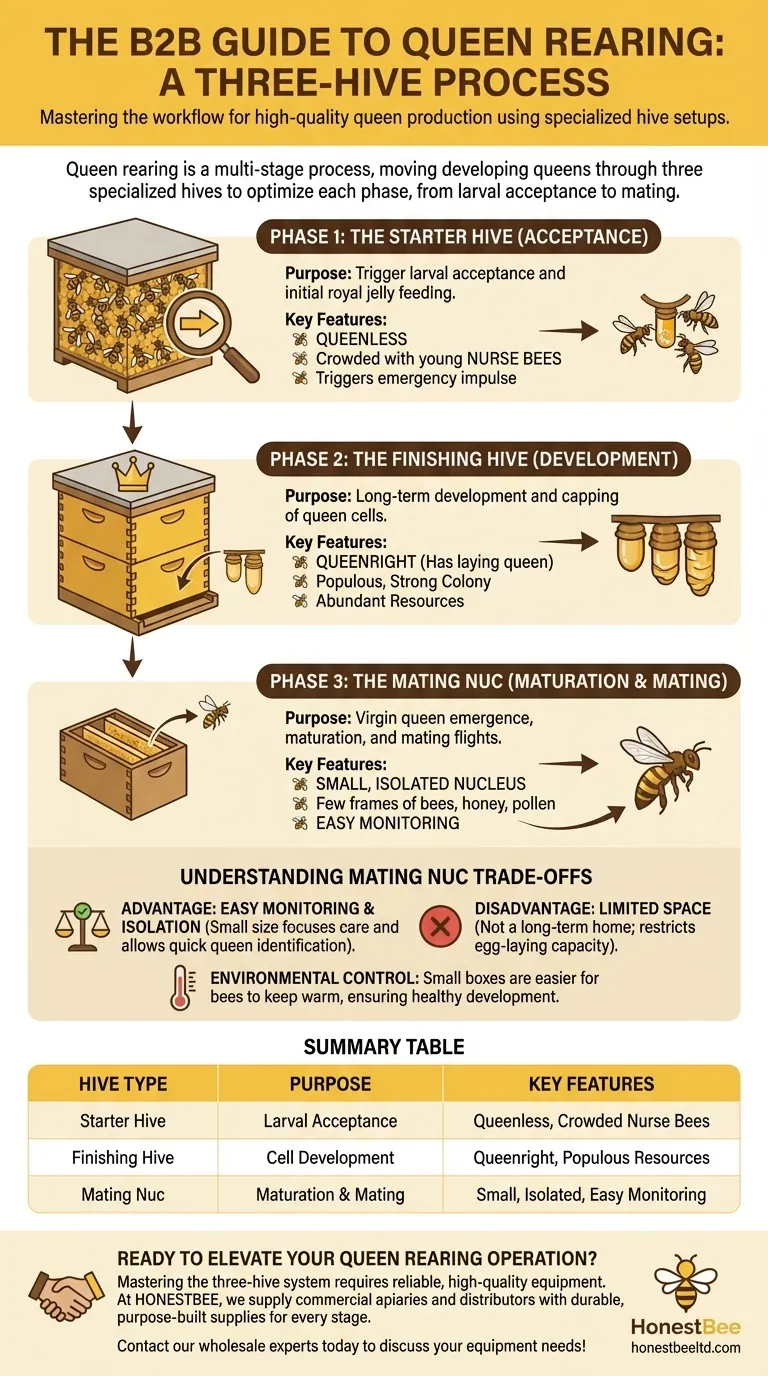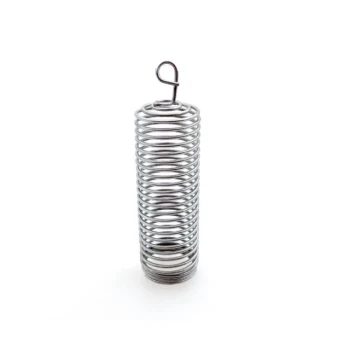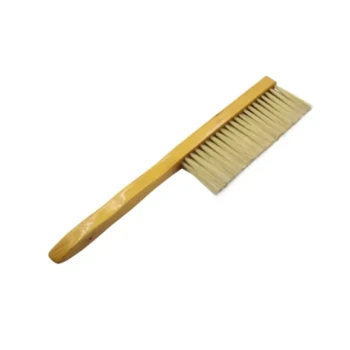To raise new queen bees, beekeepers use a sequence of three specialized hive setups. These are the starter hive for initial larval care, the finishing hive where queen cells are sealed, and the mating nuc (nucleus hive) where a new queen emerges and takes her mating flights.
Queen rearing is not about a single specialized hive, but a multi-stage process. Each hive type is a tool designed to optimize a specific phase of the queen's development, from larval acceptance to her eventual mating.

The Journey of a New Queen: A Three-Hive Process
Raising high-quality queens requires controlling the environment and colony dynamics at each stage of development. This is achieved by moving developing queens through a series of hives, each with a specific purpose.
Phase 1: The Starter Hive (Acceptance)
The first step is to convince a colony to feed royal jelly to very young larvae, starting them on the path to becoming queens.
A starter hive is typically a strong, queenless box crowded with young nurse bees. This queenless state triggers the bees' emergency impulse to raise a new queen, ensuring they readily accept the grafted larvae and begin feeding them.
Phase 2: The Finishing Hive (Development)
Once the queen cells have been started, they are moved to a finisher hive for the long-term development phase.
This hive is a populous, queenright colony (it has a laying queen) with abundant resources. The nurse bees in this strong colony will continue to feed the developing queens and eventually cap their cells.
Phase 3: The Mating Nuc (Maturation & Mating)
The final stage requires a small, isolated environment for the virgin queen to emerge, mature, and mate.
A mating nuc is a small nucleus box with a few frames of bees, honey, and pollen. Its small size makes it easy to find and monitor the new queen after she returns from her mating flights.
Understanding the Trade-offs of Mating Nucs
Mating nucs are the most distinct piece of equipment in queen rearing, and their design involves specific advantages and limitations.
Why Small Size Is an Advantage
The small population of a nuc allows a beekeeper to easily track and identify the new queen. It isolates her from other colonies and focuses the small workforce on caring for her until she is proven to be well-mated.
The Inherent Disadvantage: Limited Space
A nuc's primary drawback is its size. It is not a long-term home for a queen, as the limited space will quickly restrict her egg-laying capacity. Once mated and laying, she must be moved to a full-sized production hive.
Environmental Control is Key
The smaller, controlled environment of a wooden nuc box is easier for the small cluster of bees to keep warm. This stable temperature is critical for ensuring the queen and her initial brood develop healthily.
Making the Right Choice for Your Goal
Using the correct hive setup at the correct time is the foundation of successful queen rearing.
- If your primary focus is initiating queen cells: You must use a densely populated, queenless starter hive to maximize cell acceptance.
- If your primary focus is growing robust queens: You need a powerful finishing hive with ample food and nurse bees to care for the developing cells.
- If your primary focus is getting queens mated and evaluated: You need multiple, well-provisioned mating nucs for isolation and easy management.
Ultimately, mastering queen rearing means mastering the workflow between these specialized hive environments.
Summary Table:
| Hive Type | Purpose | Key Features |
|---|---|---|
| Starter Hive | Larval Acceptance | Queenless, crowded with nurse bees |
| Finishing Hive | Cell Development | Queenright, populous with abundant resources |
| Mating Nuc | Maturation & Mating | Small, isolated box for easy monitoring |
Ready to Elevate Your Queen Rearing Operation?
Mastering the three-hive system requires reliable, high-quality equipment. At HONESTBEE, we supply commercial apiaries and beekeeping equipment distributors with the durable, purpose-built supplies needed for every stage of queen production—from robust starter hives to efficient mating nucs.
Let us help you build a more productive and profitable queen rearing workflow. Contact our wholesale experts today to discuss your equipment needs!
Visual Guide

Related Products
- No Grafting Queen Rearing Kit: System for Royal Jelly Production and Queen Rearing
- Double Head Beekeeping Grafting Tools for Beekeepers
- Durable Galvanized Steel Spring Queen Bee Cage
- HONESTBEE Advanced Ergonomic Stainless Steel Hive Tool for Beekeeping
- Plastic Chinese Queen Grafting Tool for Bee Queen Rearing
People Also Ask
- What should be done once eggs are present in the comb box? A Guide to Maximizing Queen Rearing Success
- What are the signs that indicate a colony needs requeening? Protect Your Hive's Health and Productivity
- What are the stages involved in queen raising? A Guide to Controlled, High-Quality Queen Production
- What is requeening, and why is it performed? Take Control of Your Hive's Health and Productivity
- What is the timeline for queen breeding? A 28-Day Guide from Egg to Laying Queen



















